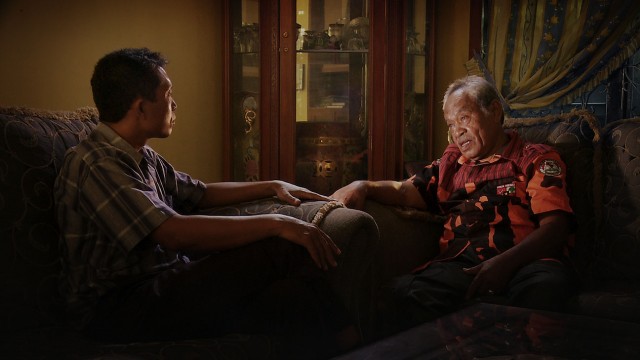Joshua Oppenheimer and Christine Cynn’s 2012 documentary, The Act of Killing, examined a political genocide of Communist members that led to the rise of power of the current political party in Indonesia. That film looked at the genocide from the point of view of the killers, re-enacting the murders through their own genre-centric fantasies recasting the killers as cinematic heroes. While The Act of Killing is essentially critical of the killers, it never devotes much time to the victims.
Oppenheimer’s companion film, The Look of Silence, centers on Adi, a village ophthalmologist giving lenses to the hard of sight in his village. Adi’s brother Ramli was a victim of the original killing, whose murder was so brutal and humiliating that it was memorialized in the killers’ instructional texts. Adi’s parents never sought justice for the loss of their son, fearing for their life if they rock the boat. As Adi’s father, somewhere around 100 years old and suffering from extreme dementia, approaches his own demise, Adi decides he needs to confront the murderers in an attempt to…seek justice? provide his own peace of mind? finally come to terms with a missing hole in his family?
Where The Act of Killing was a confrontationally artistic meditation on the brutality of the killers, The Look of Silence is more interested in traditional face-to-face confrontation with the killers and/or their families. Oppenheimer faces the theory that the Indonesian people are turning a blind eye to the bloody history of their government time and again as Adi’s “gotcha” confrontations receive a range of responses from denial to confusion to the reveal of family secrets to matter-of-fact bluntness. The emotions that the killers face when confronted with a real life victim couldn’t be more starkly contrasted with their reveling in the original documentary. Perhaps the most telling of the responses is when one of the killers bluntly states that it was a revolution, and revolutions are always bloody and frequently unsparing.
These interviews are far from the Nuremberg trials this type of film promises, but their more intimate nature serves the purpose of confrontation. But, where Oppenheimer comes up short is his focus on Adi’s parents, or more especially Adi’s father. At times, Oppenheimer films Adi’s blind and not-altogether father as he struggles with life. At one point, Oppenheimer captures his father as he forgets where he is, demands to be taken home, then runs into a wall and starts crying. His presentation of the father borders exploitative far closer than anything he did in The Act of Killing, to the film’s detriment. Oppenheimer may believe that this is reality uninterrupted, or that the suffering of Adi’s parents present some deeper Job-esque truth about being forced to eternally live through constant suffering, but some of these scenes comes off as callous, cruel, and almost mocking.
The Look of Silence is a fascinatingly confrontational film that nevertheless feels more than a little exploitative. The questions it asks have answers that may be oblique or not altogether satisfying, but the mere act of asking is a necessary part of reconciliation. Just by having these confrontations, The Look of Silence becomes something unique and special, even if needs to deal with its own morality.

